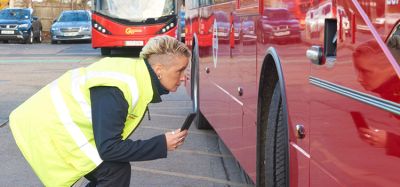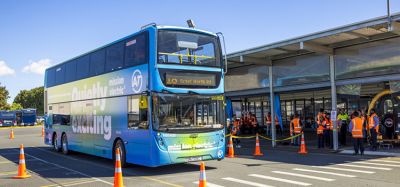The large scale test programme in the METRO project
- Like
- Digg
- Del
- Tumblr
- VKontakte
- Buffer
- Love This
- Odnoklassniki
- Meneame
- Blogger
- Amazon
- Yahoo Mail
- Gmail
- AOL
- Newsvine
- HackerNews
- Evernote
- MySpace
- Mail.ru
- Viadeo
- Line
- Comments
- Yummly
- SMS
- Viber
- Telegram
- Subscribe
- Skype
- Facebook Messenger
- Kakao
- LiveJournal
- Yammer
- Edgar
- Fintel
- Mix
- Instapaper
- Copy Link
Posted: 3 January 2012 | Haukur Ingason, Professor of Fire Protection Engineering at the Department of Fire Technology at SP Technical Research Institute of Sweden and Anders Lönnermark, Senior Research Scientist at the Department of Fire Technology at SP Technical Research Institute of Sweden | No comments yet
In September 2011, the Swedish METRO project finalised a large scale test programme in an abandoned railway tunnel. The objective of the METRO project is to improve safety in underground metro systems and to explore differences in the fire behaviour of the carriage using different types of interior materials. Further, the role of passenger luggage in the fire development was investigated. The test programme included both fire and explosion tests. The results are still undergoing analysis, but the test programme has already generated lots of new interesting information to report on. One thing that has become clear is the importance of the choice of lining material and the effects of passenger luggage on the fire spread.
About the large scale tests
A total of four tests were carried out in the 276m-long Brunsberg tunnel outside Arvika, Sweden. The abandoned tunnel was taken out of service when a new tunnel was constructed to reduce the sharpness of a bend in the route. Three fire tests using liquefied fuel as the ignition source were carried out first. The first test was a small pan with diesel oil mounted under the carriage while tests two and three were simulated arson attacks inside the carriage using petrol poured on a seat. A total of two carriages were used for the three fire tests.
In September 2011, the Swedish METRO project finalised a large scale test programme in an abandoned railway tunnel. The objective of the METRO project is to improve safety in underground metro systems and to explore differences in the fire behaviour of the carriage using different types of interior materials. Further, the role of passenger luggage in the fire development was investigated. The test programme included both fire and explosion tests. The results are still undergoing analysis, but the test programme has already generated lots of new interesting information to report on. One thing that has become clear is the importance of the choice of lining material and the effects of passenger luggage on the fire spread. About the large scale tests A total of four tests were carried out in the 276m-long Brunsberg tunnel outside Arvika, Sweden. The abandoned tunnel was taken out of service when a new tunnel was constructed to reduce the sharpness of a bend in the route. Three fire tests using liquefied fuel as the ignition source were carried out first. The first test was a small pan with diesel oil mounted under the carriage while tests two and three were simulated arson attacks inside the carriage using petrol poured on a seat. A total of two carriages were used for the three fire tests.
In September 2011, the Swedish METRO project finalised a large scale test programme in an abandoned railway tunnel. The objective of the METRO project is to improve safety in underground metro systems and to explore differences in the fire behaviour of the carriage using different types of interior materials. Further, the role of passenger luggage in the fire development was investigated. The test programme included both fire and explosion tests. The results are still undergoing analysis, but the test programme has already generated lots of new interesting information to report on. One thing that has become clear is the importance of the choice of lining material and the effects of passenger luggage on the fire spread.
About the large scale tests
A total of four tests were carried out in the 276m-long Brunsberg tunnel outside Arvika, Sweden. The abandoned tunnel was taken out of service when a new tunnel was constructed to reduce the sharpness of a bend in the route. Three fire tests using liquefied fuel as the ignition source were carried out first. The first test was a small pan with diesel oil mounted under the carriage while tests two and three were simulated arson attacks inside the carriage using petrol poured on a seat. A total of two carriages were used for the three fire tests. The fire under the carriage did not spread, mainly because there was high wind speed under the wagon, and the fire load was limited. The most dramatic difference in the fire development inside the carriages was found between the test with wall and ceiling linings found in older commuter metro car types in Stockholm and the second car with linings of non-combustible material. In many modern metro cars, the wall and ceiling linings are non-combustible material. In the test with noncombustible linings, the fire did not spread inside the wagon, at least not the first one hour and 48 minutes. After this time, the fire started to develop as it spread to the driver cabin, which became flashed over in a short time. With the old type of material, the fire spread much more rapidly, and flashover was obtained within several minutes. In both tests, a passenger luggage loading of about 5kg/m2 was used. The use of luggage as the simulated fire load was prompted by a survey carried out by Mälardalen University in the Stockholm metro which showed that the amount of luggage people carry with them was in that order. Using passenger luggage has not previously been used in these types of fire tests. Laboratory tests carried out in the intermediate scale, show the importance of the luggage for the fire spread. The laboratory tests carried out at SP in co-operation with Mälardalen University are a part of the METRO project, and aim to develop better information on the key parameter for the fire spread.
The explosion test was carried out using two connected carriages. The explosive material was placed inside one of the carriages. Pressure gages were place in both carriages, and in the tunnel. The test was successful and the data and post-observation of the damages will be used for modelling and simulation of a terrorist attack in a metro system.
Difficult job
Performing fire tests such as these requires significant resources, so the data acquisition was comprehensive. Gas temperatures at numerous positions, heat release rates, gas concentrations and smoke inside the carriage and the tunnel, as well as radiant fluxes and gas velocities, were measured. In addition, the tests were filmed from several different angles using both ordinary video and infra-red cameras. In order to make the heat release rate measurements possible, a mobile fan was placed at the one end of the tunnel. This made it possible to direct the flow towards the measuring station on the downstream side of the tunnel. The carriage was placed about 100m inside the tunnel entrance and the mobile fan which was placed just inside that entrance.
Fire and rescue personnel from the Greater Stockholm, Arvika and Höga Kusten-Ådalen Fire brigades were involved in the tests in order to investigate methods of tactical response to such fires. The behaviour of personnel and thermal loads to which personnel are exposed during this type of firefighting was also investigated.
The test results obtained will be of value in a number of areas, including:
- As input for fire design rating
- Investigating evacuation methods
- Assessment of effects of fire exposure on people in the tunnel
- Assessment of effects of fire exposure on equipment and infrastructure in the tunnel;
- Investigating methods of tackling such fires
- Scaling model development, and validation of simulation calculations.
Seminar held when performing the test
A two-day seminar in connection with the large-scale tests was attended by over 170 participants from 18 countries. On the first day, participants had the option to visit the tunnel aboard buses laid on to transfer them from the conference centre to the tunnel. Having arrived at the test site, the groups disembarked and boarded trolleys as the buses could not park closer than 300m from the portal. Visitors were allowed to enter the tunnel and walk past the carriage that was to be tested. This site visit was much appreciated, because visitors had the opportunity to smell, feel and touch the test object before the actual test.
Once back at the conference centre, they were able to watch a live broadcast of the tests on television screens in the auditorium. They could also listen-in to the live radio communications between the fire brigades and testing personnel. A few presentations about the project and other related subjects were given to the attendees while they awaited the tests to start, a measure which was highly appreciated. The following day, presentations were given about various fire safety aspects of metro systems, as well as about the test results. This offered a workshop-style atmosphere for open discussion of tunnel fire safety together with the aim of the tests and the results developed.
Lessons learned
It is clear that this type of large-scale testing is both complicated and difficult to accomplish. With only few tests possible there was limited potential to vary the different parameters and conditions. Nevertheless, what became clear was the importance of the choice of lining materials inside the carriage on the fire behaviour.
Further, the importance of luggage and its contribution to the overall fire load was clearly demonstrated – its involvement in a fire can lead to a very rapid fire spread. On the other hand, high-performance lining materials can considerably delay the onset of flashover.
A phenomenon previously seen in tests carried out by SP Technical Research Institute of Sweden in 2003 in the Runehamar tunnel was once again observed in the tests this September, i.e., the bulk of air in the tunnel started to pulsate, resulting in flames and smoke travelling backwards and forwards at a very precise frequency. The control of back-layering was shown to be very important.
When a mobile ventilator could no longer maintain the set speed due to the size of the fire, a rapid development of back layering occurred. This surprised the fire fighters inside the tunnel. The heat release rate was most likely higher than obtained in other similar tests, but the final results of the analysis will be given at the International Symposium on Tunnel Safety and Security conference in New York on 14-16 March 2012 (www.istss.se ).
Facts about the METRO project
The METRO project is a Swedish research project about infrastructure protection. Mälardalen University is leading the project while SP Technical Research Institute of Sweden is responsible for the large scale tests and FOI Swedish Defence Research Agency for the explosion test. The focus of the project is on the protection of underground rail mass transport systems, e.g. tunnels and subway stations, and both fire and explosion hazards are studied. It is a multidisciplinary project where researchers from nine different disciplines cooperate with practitioners with the common goal to make underground rail mass transport systems safer in the future. The following nine partners participate in METRO: Mälardalen University, SP Technical Research Institute of Sweden, Lund University, Swedish Defence Research Agency (FOI), Gävle University, Swedish National Defence College, Swedish Fortifications Agency, Greater Stockholm Fire Brigade and Stockholm Public Transport (SL).
The total budget of METRO is 14.2 million SEK, and the project runs over a period of three years (December 2009 to December 2012). METRO is funded by the following five organisations: Stockholm Public Transport (SL), Swedish Civil Contingencies Agency (MSB), the Swedish Transport Administration (Trafikverket), the Swedish Fortifications Agency (Fortifikationsverket), and the Swedish Fire Research Board (Brandforsk).
The work in METRO is divided into seven work packages (WPs) which address different aspects of the studied topic:
- WP1 – Design Fires
- WP2 – Evacuation
- WP3 – Integrated Fire Control
- WP4 – Smoke Control
- WP5 – Extraordinary Strain on Constructions
- WP6 – Fire and Rescue Operations
- WP7 – Project Management.
More information about METRO can be found at www.metroproject.se.
Professor Haukur Ingason has over 20 years of international experience in fire safety research and engineering. He has been involved in large scale and model scale studies of fire and smoke spread in tunnels since 1992. He was the initiator and project leader of the Runehamar tests in 2003. Haukur gives PhD courses and supervises in fire safety in underground facilities at Mälardalen University.
Dr. Anders Lönnermark is a Senior Research Scientist at the Department of Fire Technology at SP Technical Research Institute of Sweden, where he has been employed since 1995. Lönnermark has a long experi – ence of performing fire tests, both in modelscale and in full scale. In 2003 Lönnermark was responsible for the performance of the largescale tests in the Runehamar tunnel. In 2005 he got his PhD degree from Lund University and the title of the thesis was ‘On the Characteristics Using a mobile ventilator was a very important task in the full scale programme of Fires in Tunnels’.
Related topics
Fleet Management & Maintenance, Transport Governance & Policy, Vehicle & Passenger Safety
Issue
Issue 6 2011
Related organisations
SP Technical Research Institute of Sweden
Related people
Haukur Ingason








